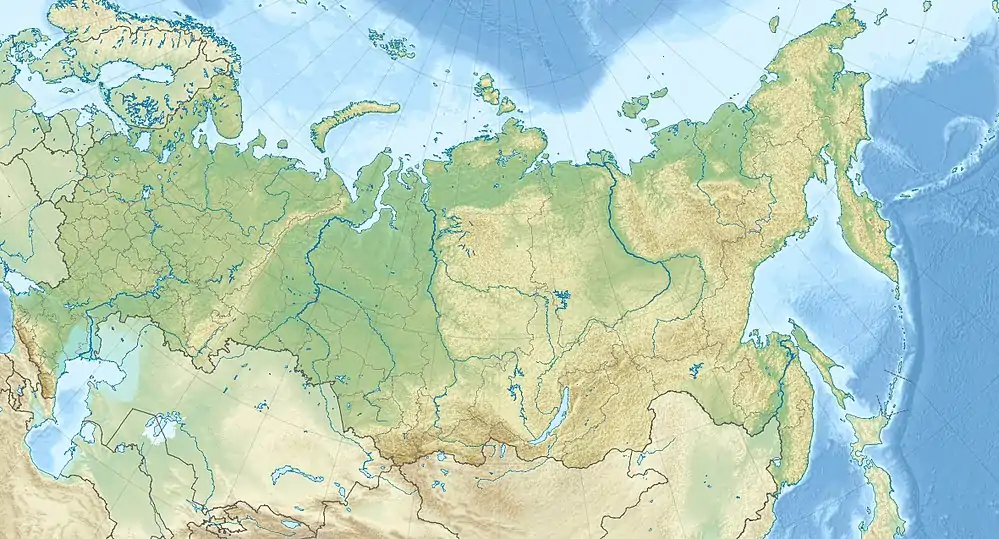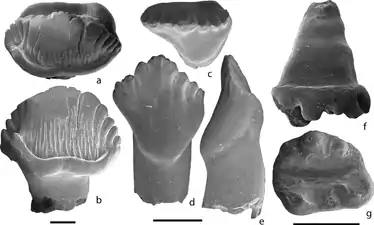Batylykh Formation
The Batylykh Formation is a geological formation in Yakutia, Russia. It is of an uncertain Early Cretaceous age, probably dating between the Berriasian and the Barremian. It is the oldest unit of the 1,500 metres (4,900 ft) thick Sangar Series within the Vilyuy syneclise. The mudstones, sandstones and shales of the formation were deposited in a fluvial to lacustrine environment.
| Batylykh Formation Stratigraphic range: Early Cretaceous ?Berriasian–Barremian | |
|---|---|
 Teete locality with stratigraphic column | |
| Type | Geological formation |
| Unit of | Sangar Series |
| Underlies | Eksenyakh Formation |
| Lithology | |
| Primary | Claystone, siltstone, sandstone |
| Location | |
| Coordinates | 62.7°N 117.6°E |
| Approximate paleocoordinates | 66.5°N 110.1°E |
| Region | Yakutia |
| Country | |
| Extent | Vilyuy River Basin |
 Batylykh Formation (Russia) | |
Fossil content
The formation is best known for the Teete locality, which has revealed remains of numerous vertebrates, including sauropods,[1] and other dinosaur teeth as well as numerous species of mammal, including Sangarotherium, Khorotherium[2] and tritylodontid Xenocretosuchus[3]. as well as choristodere Khurendukhosaurus.[4]
Other fossils recovered from the formation are:[5]
- Mammals
- Cryoharamiya tarda[6]
- cf. Sineleutherus sp.
- Docodonta indet.
- Reptiles
- Ankylosauria indet.
- Coelurosauria indet.
- Lacertilia indet.
- Macronaria indet.
- Mesochelydia indet.[7]
- Theropoda indet.
- Amphibians
- Kulgeriherpeton ultimus[8]
- Anura indet.
- Caudata indet.
- Fish
- Insects
- Bivalves
- Gastropods
- Flora
- Podocarpus multesima
- Selaginella velata
- Stereisporites compactus
- S. congregatus
- Tripartina variabilis
- Ginkgocycadophytus sp.
- Klukisporites sp.
- Leiotriletes sp.
- Ophyoglossum sp.
- Piceapollenites sp.
- Picea sp.
- Pinus sp.
- Selaginella sp.
- Stereisporites sp.
- Pinaceae indet.
Gallery
 Dinosaur teeth
Dinosaur teeth_and_ventral_(B)_views.jpg.webp) Kulgeriherpeton ultimum
Kulgeriherpeton ultimum
See also
- List of fossiliferous stratigraphic units in Russia
- Bukachacha Formation, contemporaneous fossiliferous formation of Zabaykalsky Krai
References
- Averianov et al., 2019
- Averianov et al., 2018
- Lopatin & Agadjanian, 2008
- Kolosov et al., 2009
- Batylykh Formation at Fossilworks.org
- Averianov et al., 2020
- Skutschas et al., 2020
- Skutschas et al., 2018
- Lukashevich, 1995
Bibliography
- Averianov, Alexander O.; Thomas Martin; Alexey V. Lopatin; Pavel P. Skutschas; Rico Schellhorn; Petr N. Kolosov, and Dmitry D. Vitenko. 2020. A new euharamiyidan mammaliaform from the Lower Cretaceous of Yakutia, Russia. Journal of Vertebrate Paleontology 39. e1762089. doi:10.1080/02724634.2019.1762089
- Skutschas, P.P.; V.D. Markova; V.V. Kolchanov; A.O. Averianov; T. Martin; R. Schellhorn; P.N. Kolosov; D.V. Grigoriev, and D.D., E. Mobraztsova and I. G. Danilov Vitenko. 2020. Basal turtle material from the Lower Cretaceous of Yakutia (Russia) filling the gap in the Asian record. Cretaceous Research x. 1-14.
- Averianov, Alexander O.; Pavel P. Skutschas; Rico Schellhorn; Alexey V. Lopatin; Petr N. Kolosov; Veniamin V. Kolchanov; Dmitry D. Vitenko; Dmitry V. Grigoriev, and Thomas Martin. 2019. The northernmost sauropod record in the Northern Hemisphere: Polar sauropods. Lethaia . . doi:10.1111/let.12362
- Averianov, Alexander; Thomas Martin; Alexey Lopatin; Pavel Skutschas; Rico Schellhorn; Petr Kolosov, and Dmitry Vitenko. 2018. A high-latitude fauna of mid-Mesozoic mammals from Yakutia, Russia. PLoS ONE 13. e0199983. doi:10.1371/journal.pone.0199983 ISSN 1932-6203 PMC 6059412 PMID 30044817
- Skutschas, P.P.; V.V. Kolchanov; A.O. Averianov; T. Martin; R. Schellhorn; P.N. Kolosov, and D.D. Vitenko. 2018. A new relict stem salamander from the Early Cretaceous of Yakutia, Siberian Russia. Acta Palaeontologica Polonica 63. 519-525.
- Kolosov, P.N.; G.V. Ivensen; T.E. Mikhailova; S.M. Kurzanov; M.B. Efimov, and Y.M. Gubin. 2009. Taphonomy of the Upper Mesozoic Tetrapod Teete Locality (Yakutia). Paleontological Journal 43. 201-207.
- Lopatin, Alexey, and A. Agadjanian. 2008. A Tritylodont (Tritylodontidae, Synapsida) from the Mesozoic of Yakutia. Doklady Biological Sciences 419. 107-110.
- Lukashevich, E.D. 1995. First pupae of the Eoptychopteridae and Ptychopteridae from the Mesozoic of Siberia (Insecta: Diptera). Paleontological Journal 29. 164-171.
Further reading
- I. P. Tolmachoff. 1904. Neue Funde zur Geologie Sibiriens [New discoveries about the geology of Siberia]. Centralblatt für Mineralogie, Geologie und Paläontologie 1904(1):233-234
This article is issued from Wikipedia. The text is licensed under Creative Commons - Attribution - Sharealike. Additional terms may apply for the media files.